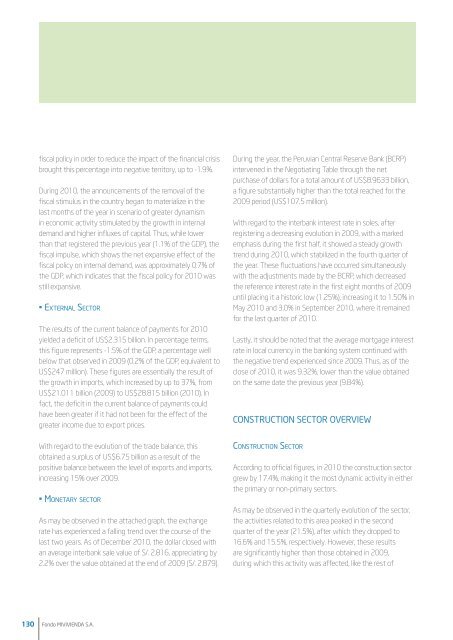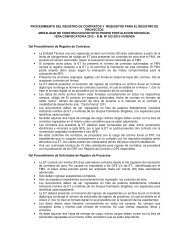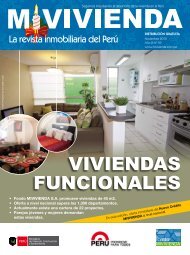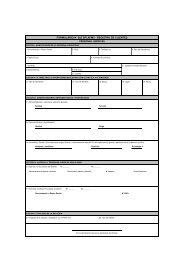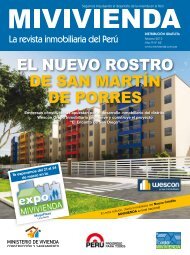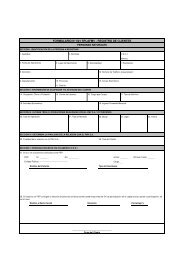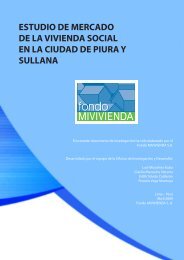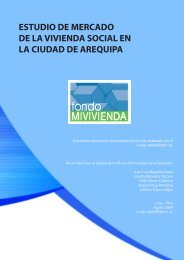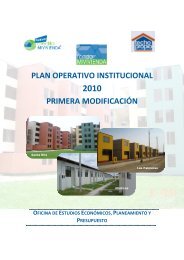Capítulo I Presentación
Memoria Anual 2010 - Fondo MIVIVIENDA
Memoria Anual 2010 - Fondo MIVIVIENDA
Create successful ePaper yourself
Turn your PDF publications into a flip-book with our unique Google optimized e-Paper software.
TranslationInto Englishfiscal policy in order to reduce the impact of the financial crisisbrought this percentage into negative territory, up to -1.9%.During 2010, the announcements of the removal of thefiscal stimulus in the country began to materialize in thelast months of the year in scenario of greater dynamismin economic activity stimulated by the growth in internaldemand and higher influxes of capital. Thus, while lowerthan that registered the previous year (1.1% of the GDP), thefiscal impulse, which shows the net expansive effect of thefiscal policy on internal demand, was approximately 0.7% ofthe GDP, which indicates that the fiscal policy for 2010 wasstill expansive.• Ex te r n a l SectorThe results of the current balance of payments for 2010yielded a deficit of US$2.315 billion. In percentage terms,this figure represents -1.5% of the GDP, a percentage wellbelow that observed in 2009 (0.2% of the GDP, equivalent toUS$247 million). These figures are essentially the result ofthe growth in imports, which increased by up to 37%, fromUS$21.011 billion (2009) to US$28.815 billion (2010). Infact, the deficit in the current balance of payments couldhave been greater if it had not been for the effect of thegreater income due to export prices.With regard to the evolution of the trade balance, thisobtained a surplus of US$6.75 billion as a result of thepositive balance between the level of exports and imports,increasing 15% over 2009.• Mo n e ta r y sectorAs may be observed in the attached graph, the exchangerate has experienced a falling trend over the course of thelast two years. As of December 2010, the dollar closed withan average interbank sale value of S/. 2.816, appreciating by2.2% over the value obtained at the end of 2009 (S/. 2.879).During the year, the Peruvian Central Reserve Bank (BCRP)intervened in the Negotiating Table through the netpurchase of dollars for a total amount of US$8.9633 billion,a figure substantially higher than the total reached for the2009 period (US$107.5 million).With regard to the interbank interest rate in soles, afterregistering a decreasing evolution in 2009, with a markedemphasis during the first half, it showed a steady growthtrend during 2010, which stabilized in the fourth quarter ofthe year. These fluctuations have occurred simultaneouslywith the adjustments made by the BCRP, which decreasedthe reference interest rate in the first eight months of 2009until placing it a historic low (1.25%), increasing it to 1.50% inMay 2010 and 3.0% in September 2010, where it remainedfor the last quarter of 2010.Lastly, it should be noted that the average mortgage interestrate in local currency in the banking system continued withthe negative trend experienced since 2009. Thus, as of theclose of 2010, it was 9.32%, lower than the value obtainedon the same date the previous year (9.84%).CONSTRUCTION SECTOR OVERVIEWCo n s t r u c t io n SectorAccording to official figures, in 2010 the construction sectorgrew by 17.4%, making it the most dynamic activity in eitherthe primary or non-primary sectors.As may be observed in the quarterly evolution of the sector,the activities related to this area peaked in the secondquarter of the year (21.5%), after which they dropped to16.6% and 15.5%, respectively. However, these resultsare significantly higher than those obtained in 2009,during which this activity was affected, like the rest ofthe economy, by the unfavorable international financialenvironment.According to the BCRP, the positive evolution of the sectoris a reflection of the good stretch being experiencedby the real estate, trade, hostelry and private and publicinfrastructure sectors nationwide.Measured by five-year periods, the average growth rate ofthe sector between 2001 and 2005 (3.6%) has been farexceeded by that obtained in the last five years (2006-2010), where it achieved a total of 14.2%.In terms of other indicators of the sector, the internalconsumption of cement is taken as one of the mostrepresentative of the activity, given that it jointly reflectslocal shipments of cement and imported volumes of cement,figures closely linked to the evolution of construction.The trajectory followed by the percentage variations inthe GDP of the sector and internal cement consumptionconfirm the foregoing claim. As of the close of 2010, thelatter indicator registered a cumulative variation of 15.1%over the last twelve months (December 2009 - December2010).Lastly, with regard to Fondo MIVIVIENDA S.A. (FMV S.A.),the stock of placements of its products in 2010 rose by17.4% over the previous year, the highest rate obtainedsince 2006.With regard to credit types, in 2010 FMV S.A. placeda total of 6,436 mortgage credits through the NuevoCrédito MIVIVIENDA product, equivalent to S/. 589 million;and 2,007 Techo Propio Supplementary credits, forapproximately S/. 35 million.With these results, 2010 was a period of consolidation forthe Nuevo Crédito MIVIVIENDA, and thus, for FMV S.A. asa whole. FMV S.A. obtained an annual share percentage of28.7% of all credits placed by the mortgage system in fullservicebanks.For 2010, it is hoped that the positive trend in the sectorwill continue, for the realization of major public investmentprojects as well as those of a private nature. With regardto FMV S.A., it will continue with its efforts to keepstrengthening the Nuevo Crédito MIVIVIENDA.FONDO MIVIVIENDA PRODUCTSSince the creation of Fondo MIVIVIENDA S.A., the institution,in compliance with its corporate purpose of promotingand financing the purchase, betterment and constructionof housing, especially social interest housing, has beenconcerned with improving its products in accordance withthe needs of the real estate market and interest of thehousing demand in Peru.Currently, Fondo MIVIVIENDA S.A. offers two products aimedat the purchase of housing: Nuevo Crédito MIVIVIENDA andTecho Propio.As of the end of 2010, 6,436 Nuevo Crédito MIVIVIENDAhad been granted, with 2,007 credits paid out viasupplementary financing for the Family Housing Bond ofthe Techo Propio Program. The population benefited byMIVIVIENDA products totals 112,640 people.Nuevo Crédito MiviviendaThe Nuevo Crédito MIVIVIENDA arose as a result ofimprovements made to two pre-existing products, theCrédito MIVIVIENDA and the Proyecto MIHOGAR, increasingthe value of the housing to be financed from 14 Tax Units(UITs) to 50 UITs, as well as the minimum financing value130 Fondo MIVIVIENDA S.A. Memoria Institucional 2010 131


